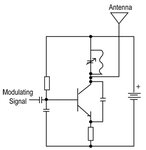LearningElectronics10
Newbie level 4
I would like to learn how to analyise circuits involving capacitors, coils, LC tanks etc
For example I already know the theory of how an astable multivibrator operates, but I would like to be able to analyse the circuit precisely from start to finish using mathematics.

I would like to also be able to answer questions such as what role does the capacitor play connected between the base and ground in the simple below circuit. If the capacitor was connected to the positive terminal in parallel to the resistor it is pretty straightforward to me: it enforeces/helps the feedback from the LC tank to the emitter.

Another question would be: What is the role of Eulers number when calculating RC circuits - I was unable to find an explanation on the internet of the purpose of the e number in the formula.
Where do I get started, what are the best websites, books for me?
I would also like to learn some of the mathematics for electronics and I would like to know if there is a book teaching math concepts such as calculus alongside electronic problems, as I feel this is the easiest way to learn.
Essentially I would like to be able to do what LTSpice can do but using a pencil and paper - this is what I would call "understanding electronics"
Ofcourse help on the mentioned problems/circuits will be also very appreciated.
For example I already know the theory of how an astable multivibrator operates, but I would like to be able to analyse the circuit precisely from start to finish using mathematics.

I would like to also be able to answer questions such as what role does the capacitor play connected between the base and ground in the simple below circuit. If the capacitor was connected to the positive terminal in parallel to the resistor it is pretty straightforward to me: it enforeces/helps the feedback from the LC tank to the emitter.

Another question would be: What is the role of Eulers number when calculating RC circuits - I was unable to find an explanation on the internet of the purpose of the e number in the formula.
Where do I get started, what are the best websites, books for me?
I would also like to learn some of the mathematics for electronics and I would like to know if there is a book teaching math concepts such as calculus alongside electronic problems, as I feel this is the easiest way to learn.
Essentially I would like to be able to do what LTSpice can do but using a pencil and paper - this is what I would call "understanding electronics"
Ofcourse help on the mentioned problems/circuits will be also very appreciated.
